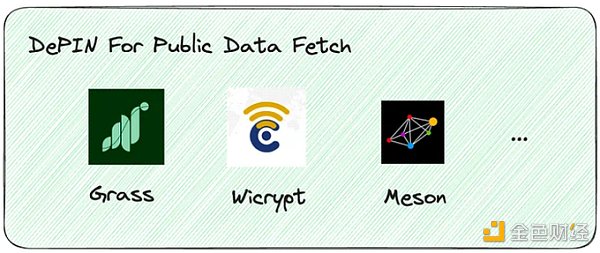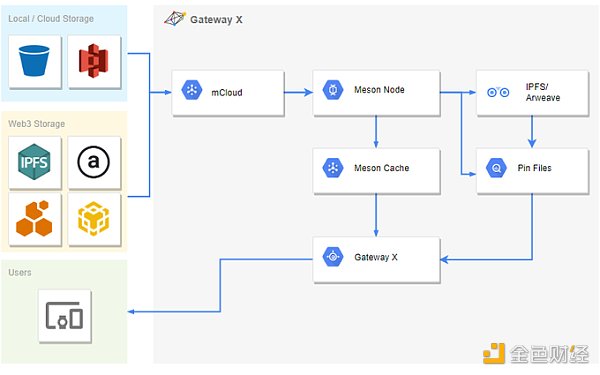Author: Riyue Xiaochu Source: X, @riyuexiaochu
1. Bandwidth is the basis of everything, including Depin and AI
Bandwidth represents the transmission capacity of data, which is the network's Connectivity. From a practical perspective, bandwidth can be thought of as a highway, a highway connecting two cities. If the highway is open, everything goes very smoothly. If the highway is congested, transportation problems between the two cities will occur, the travel time will be lengthened, and the efficiency will become low. Some fruits and vegetables go bad on the road.

In the network, bandwidth is the highway connecting computers, computing power, data centers, and personal computers. Whether it is the existing Internet or the Internet of Things, bandwidth is the foundation. Many people's stereotypes believe that bandwidth is something of the traditional Internet, which is far away from our market situation. In fact, this idea is very wrong. Because in our blockchain world, bandwidth is also extremely important. We can look at several use cases of Meson:
1. One hundred thousand decentralized nodes on the Meson network gather strength to provide high availability of Arbitrum. Centralized RPC service. Helps Arbitrum become more decentralized, improving speed and data privacy.
2. Meson dCDN helps Arweave to reduce the load requirements of the Arweave gateway, and the decentralized network can be cached closer to the user to shorten The speed of user requests from the original site. Solve the problem of small images taking too long to load.
3. BNB Chain has huge transaction data, and the synchronization snapshot of the entire network takes about 20 hours. After taking advantage of Meson Network's global node distribution, BNB Chain is significantly shortened to 1 hour.
2. The foundation of AI development
Due to the emergence of OpenAI’s GPT, it has amazed everyone . AI has become the focus of human development as a whole. We know that AI is realized through massive data + algorithms. OpenAI and Google's AI have captured the most important data on the existing Internet. To achieve another order-of-magnitude improvement at the data level, we need to obtain data from the physical world.
Depin can provide AI to provide data in the physical world. Depin, which uses blockchain technology, has a lot of overlap with the Internet of Things. Regardless of whether the project that collects physical world data uses blockchain technology, it requires decentralized bandwidth services. Because the physical world is distributed over a wide area and is not concentrated in data centers like the Internet. Then the bandwidth distributed in various places can meet the transmission of data.

3. Introduction to Meson
Meson is a new force in Depin, aiming to build a decentralized bandwidth network. It has 350,000 nodes in 150 countries/regions, achieving a bandwidth capacity of more than 20 Tb/s. Users include Filecoin, Arweave, Arbitrum, Greenfield, OKX chain, BNB chain and other well-known projects.
Meson nodes are very friendly to ordinary users and accept a variety of existing hardware such as personal computers, servers, and IoT devices. The key point is that unlike other Depin projects, you do not need to purchase a mining machine first, which greatly reduces the user's investment cost. This allows Meson to quickly grow bigger and stronger, gathering long-tail resources of bandwidth to help fields such as AI, big data, and Depin.
Analysis of Meson product line

GateWay X
Gateway X is a gateway service provided by Meson Cloud Services, which can act as a bridge between Web3 and traditional Web2. GateWay mainly brings together bandwidth providers with certain strength, including
-constant bandwidth users
- Static IP for home users
- Owners of IoT devices
- Dedicated servers Owner of
- IDC server (company/organization/school) owner.
Compared with GAGA, GateWay X is more of a stable, professional, and relatively powerful bandwidth provider. In fact, it uses the spare resources of these suppliers, or the resources that are idle at a specific time.

GaGaNode
GaGaNode was developed to help users independently control idle home bandwidth resources . Users do not need a public IP and can participate in the Web3 network through Idle Electronics at home. Users run GaGaNode's node software on Mac, Linux, Windows, Android, TV BOX and Raspberry Pi. Different from other network Depin projects, users do not need to purchase mining machines like Helium, and there is no need for early investment, which greatly reduces users’ participation costs.
It can be seen that Meson has spent a lot of effort in this area in order to add idle long-tail bandwidth resources.
IPCOLA
If GateWay X and GaGaNode are used IP and bandwidth resources are collected, and IPCOLA is responsible for profitability. IPCola is a customizable big data solution. It can provide data product support for static IP and dynamic IP.
According to information disclosed by Meson Network team members, although IP Cola is still far away from the annual revenue of over 100 million US dollars of traditional companies such as Brightdata, it is growing rapidly. , the overall revenue has exceeded one million US dollars in 6 months since its launch.
4. Current status of Meson
According to the official data panel, it represents the professional bandwidth provider GateWay X currently has 32,000 nodes and 127,000 GaGaNode nodes. There are more than 100,000 nodes from 150 countries active every day. The bandwidth capacity of GataWay X is 21.5T/s. We know that the speed of ordinary home Internet is usually between tens of Mbps and hundreds of Mbps. 21.5 Tbps is tens of thousands of times faster than this speed. Such bandwidth can support thousands of high-demand applications at the same time, such as large-scale cloud computing, high-performance computing, big data analysis, etc. Meson's bandwidth has now reached 1/10 of Akamai Technologies, the world's largest distributed computing company.
From the perspective of geographical distribution, the largest supplier of GateWay X bandwidth comes from Europe, with the number of nodes reaching 18,000, reaching 56%, and the bandwidth capacity is as high as 16.1 T/s, accounting for up to 75%. Therefore, Europe accounts for the absolute majority, followed by North America and Asia, and Africa accounts for the smallest proportion.
5. Meson project benchmarking and prospects
The bandwidth market that Meson is involved in is huge. It is worth billions of dollars every year and is growing rapidly, with an annual growth rate of about 12%. The explosive growth of AI has driven bandwidth market demand, and developers' needs for data retrieval and crawling have surged.
There are already mature and large-scale enterprises in the traditional centralized bandwidth market, which are divided into:
- Focusing on enterprise-level bandwidth Cisco/Akamai Technologies, etc.
- Focusing on home bandwidth Brightdata (annual revenue disclosed in 2023 will exceed US$100 million)< /p>
In the decentralized bandwidth market, in addition to Meson, another benchmark project is Grass led by Polychain:
Meson
- Covers enterprise nodes (32,000)/personal nodes (127,000)
- The test network has been running stably for more than two years, and the main network will be launched soon
- There is already revenue (previously) Achieving one million US dollars in 6 months)
- There are mature cooperation cases of Web 2 and Web 3 (mentioned above)
Grass
- More than 80,000 personal nodes (calculated based on desktop browser downloads)
- The testnet was just launched in June (but the community response is not very stable yet)
- No revenue for the time being
- A few Web 3 cooperation cases such as Saga mobile phone on Solana
Meson occupies the first-mover advantage in the decentralized market and has successfully bundled a large amount of bandwidth resources through the token economy. Meson is more efficient than the cold-start bandwidth resources required by centralized enterprises. Currently, Meson has achieved profitability, demonstrating the feasibility of its business model. In the next few months, the competition between Meson and Grass and Meson's revenue performance are worthy of attention.
6. Token Economics
MSN supply is 100 million, specific distribution For
- Private sale: 26,000,000 MSN (26%)
- After TGE , unlocked linearly every month, lasting 12-36 months.
- Public community sale: 5,000,000 MSN (5%)
- After TGE , unlocked linearly every month for 6 months.
- Ecosystem: 27,000,000 MSN (27%)
- Complete after TGE Locked and will be unlocked linearly every month for 8 years.
- Foundation reserved: 20,000,000 MSN (20%)
- In TGE It is fully locked after that and will be unlocked linearly every month for 8 years.
-Technical team: 15,000,000 MSN (15%)
-Completely after TGE Locked and will be unlocked linearly every month for 8 years starting from the 6th month after TGE.
- Partners: 6,000,000 MSN (6%)
- Fully after TGE Locked and will be unlocked linearly every month for 6 years.
- Testnet mapping: 1,000,000 MSN (1%)
- After TGE Direct circulation.
Since the release of part of the private placement sales chips is not very specific, it is difficult to estimate. So we expect the initial circulation to be around 5%.
MSN will inflate every year to reward miners, 5% in the first year, 4.5% in the second year, 4% in the third year, and so on until the 10th year End of year.
MSN has the following functions:
- MSN tokens give users access to bandwidth and big data The ability to provide services that were previously only available to large companies like Google and Akamai.
- As a reward for Meson network miners.
- Miners who pledge MSN can increase their rewards
- Meson’s governance decisions
 Catherine
Catherine








